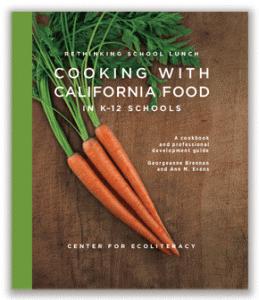 Last month I purchased Alice Waters’s Edible Schoolyard: A Universal Idea and began reading it. Once I finish it I will be sure to write a review. In the book, Waters – a renowned chef who uses local and organic ingredients – discusses the journey she undertook helping to start a school garden near her home in Berkeley, California. The Center for Ecoliteracy, which is mentioned in the book, has just released a cookbook for schools that is available as a free download. Entitled Cooking with California Food in K-12 Schools, the cookbook draws heavily from Waters’s experience and work with the Center for Ecoliteracy.
Last month I purchased Alice Waters’s Edible Schoolyard: A Universal Idea and began reading it. Once I finish it I will be sure to write a review. In the book, Waters – a renowned chef who uses local and organic ingredients – discusses the journey she undertook helping to start a school garden near her home in Berkeley, California. The Center for Ecoliteracy, which is mentioned in the book, has just released a cookbook for schools that is available as a free download. Entitled Cooking with California Food in K-12 Schools, the cookbook draws heavily from Waters’s experience and work with the Center for Ecoliteracy.
From Ecoliteracy’s website comes the following excerpt,
Cooking with California Food introduces the concept of the dynamic 6-5-4 School Lunch Matrix, based on six dishes students know and love, five ethnic flavor profiles, and four seasons. It offers ideas for adding more fresh, local, healthy foods to school lunches; helps meal services devise an appealing variety of menus around dishes that children already prefer; honors California’s rich history and cultural heritage; and describes a tested plan for effective professional development for food services staff.
According to Ecoliteracy, 900 million meals are served each year in California schools. Since many children do not get the nutrients they need from inexpensive, nutritionally deficient fast food, meals that come from school gardens using fresh ingredients present a wonderful opportunity to introduce fruits and vegetables into students’ diets.
Beyond the health component, one of the great benefits of school gardens centers around the opportunity to incorporate the garden itself into the curriculum. Lessons from math and science are obvious, but so too are social studies and language arts. Even foreign language can come alive when learning about the Latin names of plants, or what they are called in other languages. Students can supplement their understanding from textbooks with hands on experience in the garden. Furthermore, students who eat healthy meals have been shown to achieve at a higher level in schools.
The ramifications are far reaching when it comes to the impact of locally grown foods in schools. Another point made in the Ecoliteracy piece is that “changing how we grow, process, and prepare food impacts issues from health care costs to climate change, energy and resource conservation, and community vitality. The billions of dollars devoted to providing healthier school meals will boost California agriculture, invigorate local economies, and promote equity.”
Cooking with California Food is part of The Center for Ecoliteracy’s Rethinking School Lunch program. Other publications “include ideas and strategies for improving school food, teaching nutrition, supporting sustainable food systems, and designing education programs focused on understanding the relationships between food, culture, health, and the environment.”
[Image source]

